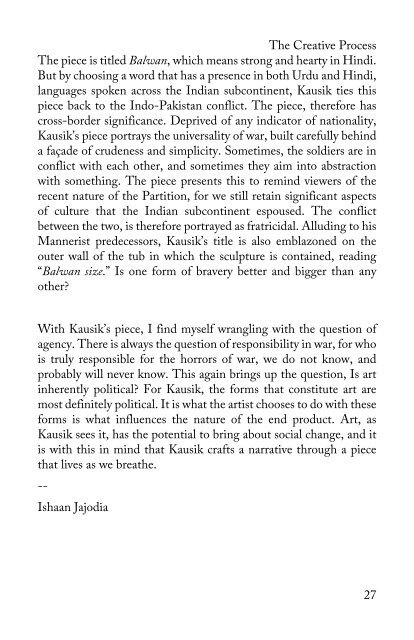The Creative Process: The Arts of War (Spring 2017)
The Creative Process is The Mumbai Art Collective's flagship magazine.
The Creative Process is The Mumbai Art Collective's flagship magazine.
Create successful ePaper yourself
Turn your PDF publications into a flip-book with our unique Google optimized e-Paper software.
<strong>The</strong> <strong>Creative</strong> <strong>Process</strong><br />
<strong>The</strong> piece is titled Balwan, which means strong and hearty in Hindi.<br />
But by choosing a word that has a presence in both Urdu and Hindi,<br />
languages spoken across the Indian subcontinent, Kausik ties this<br />
piece back to the Indo-Pakistan conflict. <strong>The</strong> piece, therefore has<br />
cross-border significance. Deprived <strong>of</strong> any indicator <strong>of</strong> nationality,<br />
Kausik’s piece portrays the universality <strong>of</strong> war, built carefully behind<br />
a façade <strong>of</strong> crudeness and simplicity. Sometimes, the soldiers are in<br />
conflict with each other, and sometimes they aim into abstraction<br />
with something. <strong>The</strong> piece presents this to remind viewers <strong>of</strong> the<br />
recent nature <strong>of</strong> the Partition, for we still retain significant aspects<br />
<strong>of</strong> culture that the Indian subcontinent espoused. <strong>The</strong> conflict<br />
between the two, is therefore portrayed as fratricidal. Alluding to his<br />
Mannerist predecessors, Kausik’s title is also emblazoned on the<br />
outer wall <strong>of</strong> the tub in which the sculpture is contained, reading<br />
“Balwan size.” Is one form <strong>of</strong> bravery better and bigger than any<br />
other?<br />
With Kausik’s piece, I find myself wrangling with the question <strong>of</strong><br />
agency. <strong>The</strong>re is always the question <strong>of</strong> responsibility in war, for who<br />
is truly responsible for the horrors <strong>of</strong> war, we do not know, and<br />
probably will never know. This again brings up the question, Is art<br />
inherently political? For Kausik, the forms that constitute art are<br />
most definitely political. It is what the artist chooses to do with these<br />
forms is what influences the nature <strong>of</strong> the end product. Art, as<br />
Kausik sees it, has the potential to bring about social change, and it<br />
is with this in mind that Kausik crafts a narrative through a piece<br />
that lives as we breathe.<br />
--<br />
Ishaan Jajodia<br />
27



